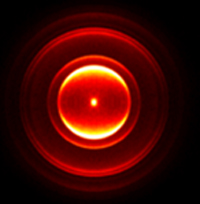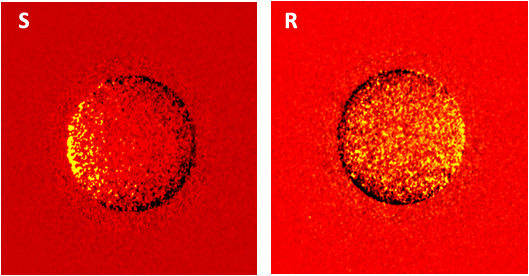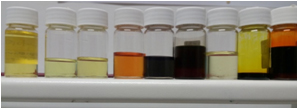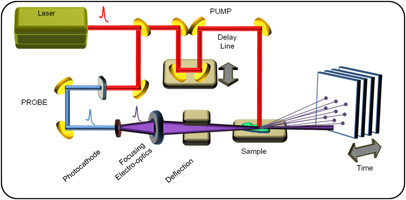Photodissociation Dynamics of highly excited molecules

When a molecule is excited with energies close to its ionization limit it can end up in Rydberg, valence (e.g. ion pair) or ionic states. The interaction between those states determines what happens to the molecule and those are what we want to understand in more detail. In collaboration with the group of Prof. A. Kvaran (University of Iceland, Iceland) we have looked into the dynamics of HBr, CH3Br, CH3I and acetylene.
In HBr, we have looked into the interaction of E-V (Zaouris et al. PCCP 17, 10468), 6pπ-V (Glodic et al. PCCP 18, 26291) and H, E and V (Hrodmarsson et al. PCCP 19, 11354) states.
CH3Br and CH3I are particularly interesting: in methyl bromide excitation energy is channeled into methyl (Haflidason et al. PCCP 20, 17423, Haflidason et al. PCCP 21, 10391) while in methyl iodide (Matthiasson et al., PCCP 22, 4984) excitation energy is channeled into the halogen atom (iodine).
Acetylene (M.X. Jiang et al. PCCP 25, 1690) gives rise to several photofragments through rich dissociation pathways.
Related publications:
D. Zaouris, A. Kartakoullis, P. Glodic, P. C. Samartzis, H.R. Hrodmarsson, A. Kvaran, Rydberg and valence state excitation dynamics: a velocity map imaging study involving the E-V state interaction in HBr, Phys Chem. Chem.Phys.17, 10468 (2015)
P. Glodic, D. Zaouris, P.C. Samartzis, A. Haflidason, A. Kvaran, Effect of a triplet to singlet state interaction on photofragmentation dynamics: highly excited states of HBr probed by VMI and REMPI as a case study, Phys Chem. Chem.Phys.18, 26291 (2016)
H. R. Hrodmarsson, A. K. Kartakoullis, D. Zaouris, P. Glodic, H. Wang, P. C. Samartzis, A. Kvaran, Excitation dynamics involving homogeneous multistate interactions: one and two color VMI and REMPI of HBr, Phys Chem. Chem.Phys.19, 11354 (2017)
A. Haflidason, P. Glodic, G. Koumarianou, P. C. Samartzis and A. Kvaran, Multiphoton Rydberg and valence dynamics of CH3Br probed by mass spectrometry and slice imaging, Phys . Chem. Chem. Phys. 20, 17423 (2018)
A. Haflidason, P. Glodic, G. Koumarianou, P. C. Samartzis and A. Kvaran, Two-color studies of CH3Br excitation dynamics with MPI and slice imaging, Phys .Chem. Chem. Phys. 21, 10391 (2019)
K. Matthiasson, G. Koumarianou, M. X. Jiang, P. Glodic, P. C. Samartzis, A. Kvaran, Formation of highly excited iodine atoms from multiphoton excitation of CH3I, Phys .Chem. Chem. Phys. 22, 4984 (2020)
M. X. Jiang, I. C. Giannakidis, P. C. Samartzis, A. Kvaran, Multiphoton breakdown of acetylene; formation of organic building block fragments, Phys. Chem. Chem. Phys. 25, 1690 (2023)
Photoelectron Circular Dichroism of chiral molecules

When chiral molecules are ionized with circularly polarized light, the electron distribution produced has a forward-backward asymmetry in the laser propagation direction, dependent on the enantiomer used and on photon helicity, an effect known as Photoelectron Circular Dichroism (PECD). We investigate if and how PECD changes with the excitation energy and scheme used to ionized the chiral molecule.
In collaboration with the teams of Tim Schaefer (Gottingen, Germany) and Thomas Baumert (Kassel, Germany), we demonstrated the first tunable nanosecond PECD data using a dye ns laser for multiphoton ionization (REMPI) of fenchone enantiomers at different wavelengths in order to discover whether PECD depends on the vibrational level of the intermediate state (Kastner et al., PCCP 22, 7404). In a second set of PECD experiments with fenchone and camphor enantiomers, we demonstrated than nanosecond PECD can detect an enantiomer target in the presence of other enantiomers (Ranecky et al. PCCP 24, 2758).
Related publications:
A. Kastner, G. Koumarianou, P. Glodic, P. C. Samartzis, N. Ladda, S. T. Ranecky, T. Ring, S. Vasudevan, C. Witte, H. Braun, H. G. Lee, A. Senftleben, R. Berger, G. B. Park, T. Schäfer, T. Baumert, High-resolution resonance-enhanced multiphoton photoelectron circular dichroism, Phys .Chem. Chem. Phys. 22, 7404 (2020)
S. T. Ranecky, G. B. Park, P. C. Samartzis, I. C. Giannakidis, D. Schwarzer, A. Senftleben, T. Baumert, T. Schäfer, Detecting chirality in mixtures using nanosecond photoelectron circular dichroism, Phys. Chem. Chem. Phys., 24, 2758 (2022)
Chemical Analysis using photons

Spectroscopic detection of (fossil) fuels adulteration:We combine statistical analysis methods and spectroscopic data (UV to NIR absorption, fluorescence, FT-IR) of pure fossil fuels (gasolines, diesels) and adulterants (solvents, lubricants, lubricants waste) and their mixtures aiming to develop a system that will detect fuel adulteration spectroscopically in a reliable, cheap and user-friendly way. This work is part of a general direction aiming to improve how we detect molecules of choice in a chemical mixture.
Time-Resolved Electron Diffraction probes for Chemistry and Materials Science

In this direction we aim to develop time-resolved electron diffraction probes for applications in chemistry and materials science. Ultrafast Electron Diffraction and similar techniques exist for more than 20 years, however they are not widely used in chemistry and materials. We want to use the lessons of those years and adapt UED for use in chemistry (e.g. dark reactions, structural dynamics) and materials science (e.g. excitation energy redistribution, lattice dynamics).